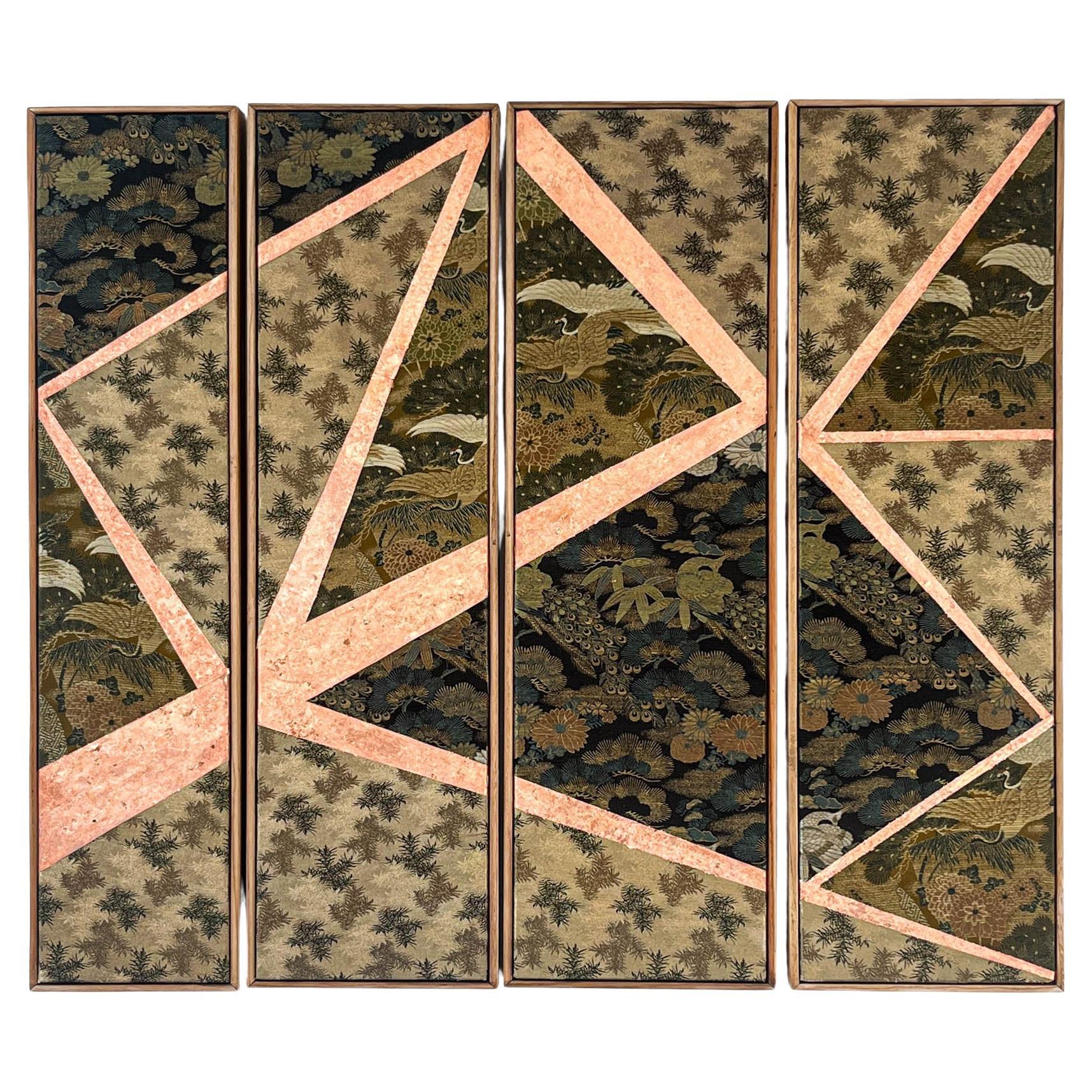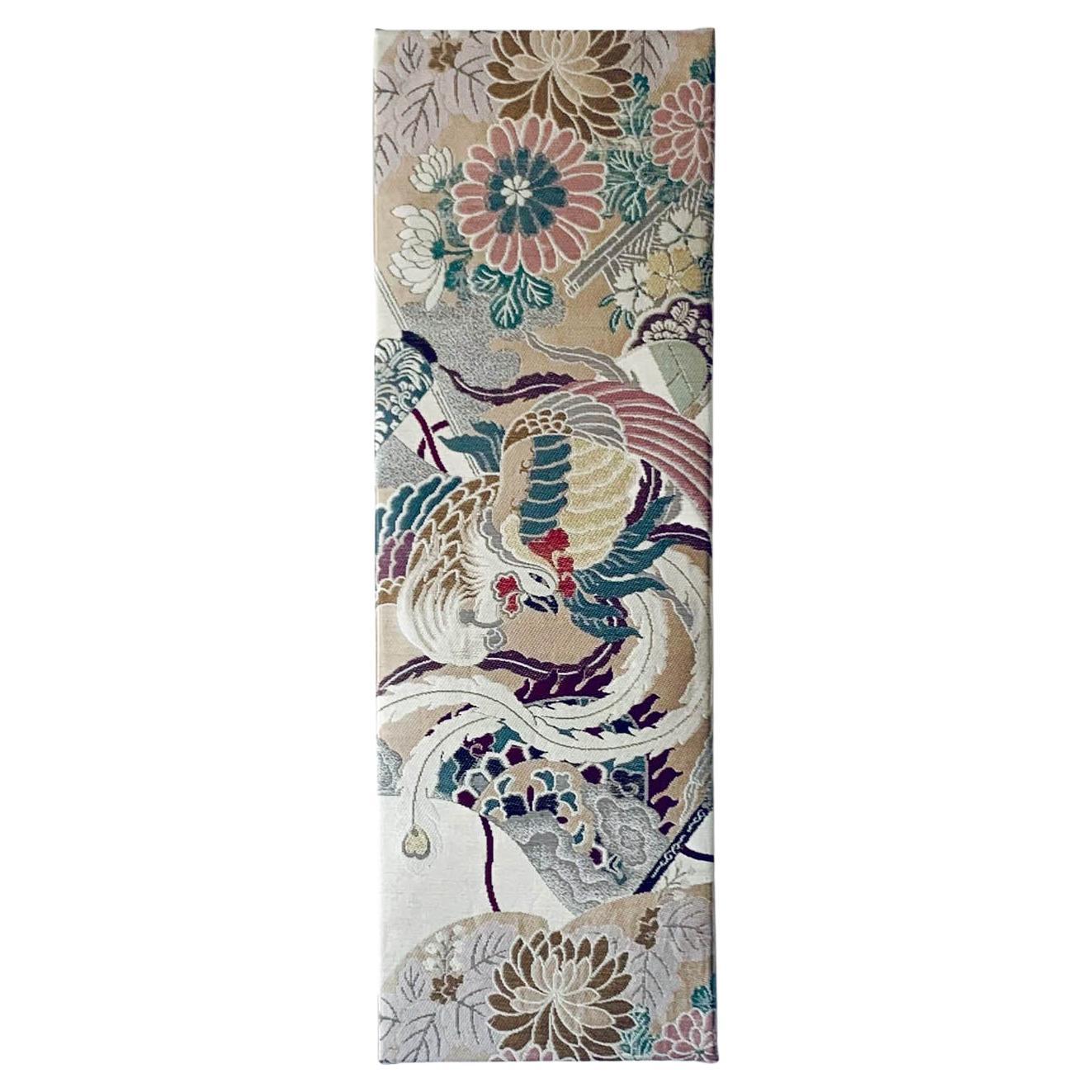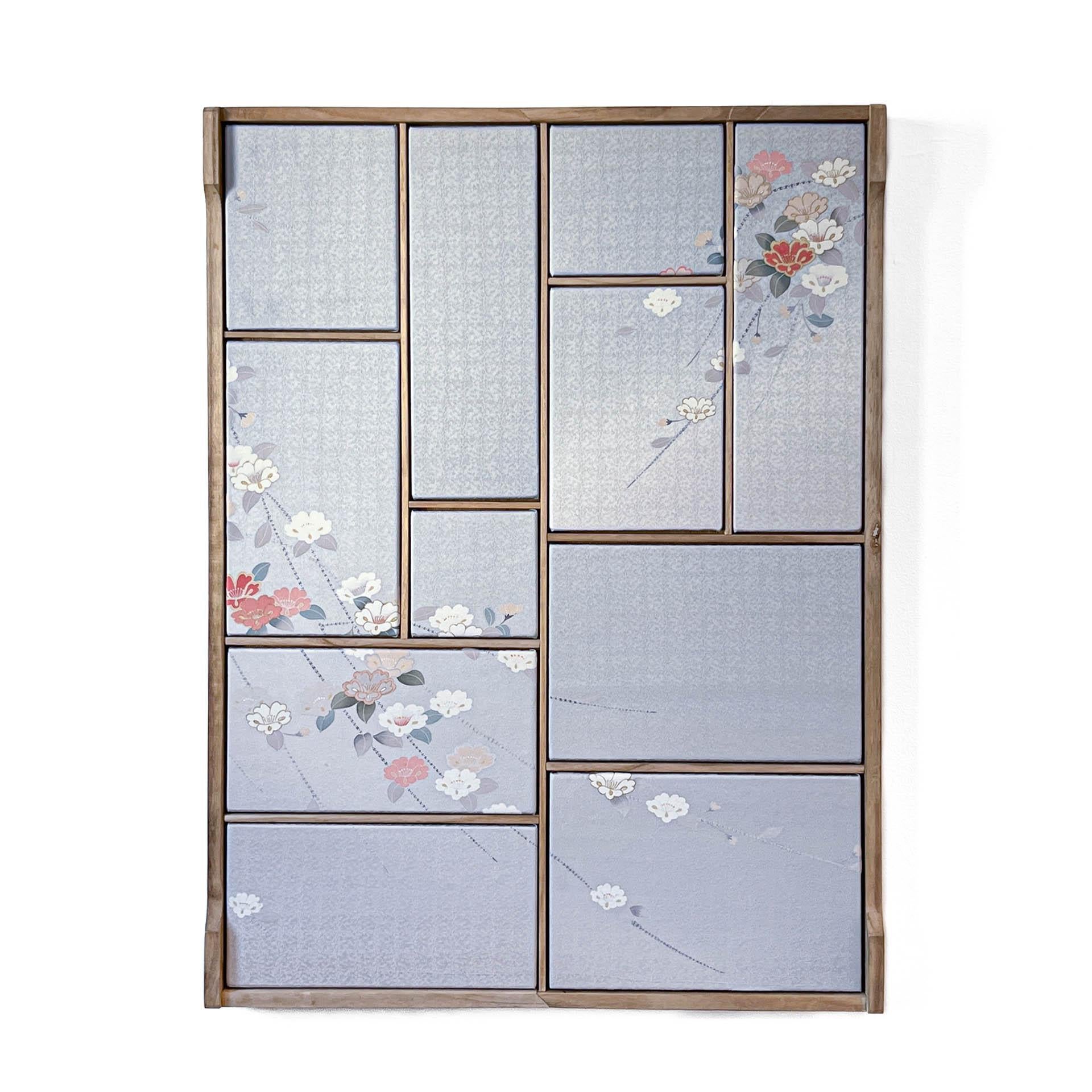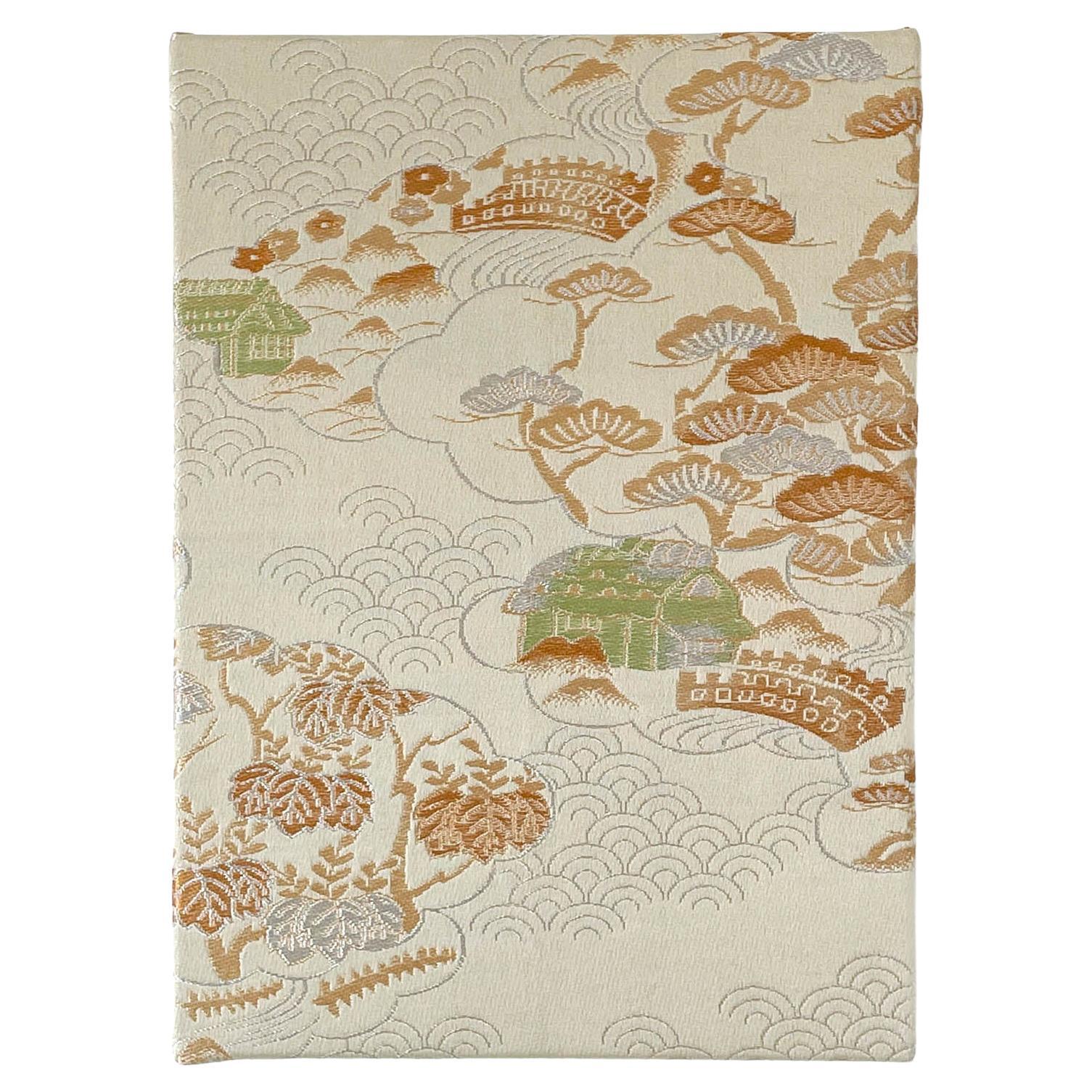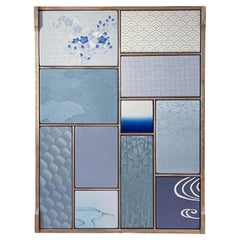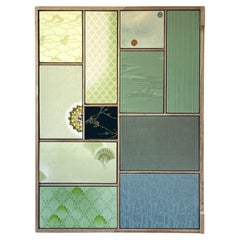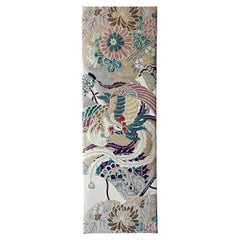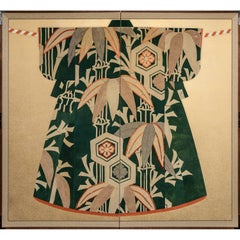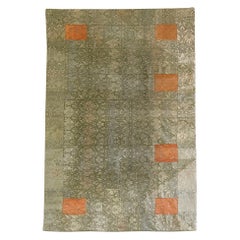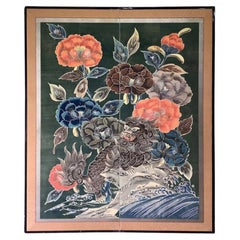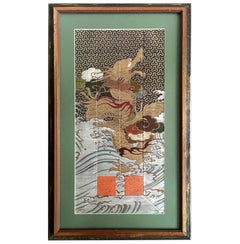Items Similar to Antique kimono textile art " Waves and clouds ~Eternity~ " by ikasu Beige, Japan
Video Loading
Want more images or videos?
Request additional images or videos from the seller
1 of 19
Antique kimono textile art " Waves and clouds ~Eternity~ " by ikasu Beige, Japan
$3,000
£2,293.66
€2,641.83
CA$4,203.92
A$4,693.28
CHF 2,459.21
MX$57,450.37
NOK 31,231.98
SEK 29,447.79
DKK 19,716.27
Shipping
Retrieving quote...The 1stDibs Promise:
Authenticity Guarantee,
Money-Back Guarantee,
24-Hour Cancellation
About the Item
This work is inspired by traditional hand-dying technique edo-komon, and is framed in paulownia wood originally used for a kimono chest-of-drawers.
It is elegantly framed with paulownia wood originally used for kimono chest-of-drawers, and is filled with storytelling and sense of luxury.
In this artwork, the aim was to capture the time consuming dyeing technique called edo-komon, commonly used in antique kimono. Traditional Japanese culture, represented by the kimono, and wood, an integral element of Japanese craftsmanship, were used to bring this vision to life.
I used pieces of kimono and haori that could no longer be used as clothing and kiritansu chest-of-drawers that would normally be discarded to create the ultimate upcycled piece.
<< Explanation and meaning of pattern and colors >>
Waves and clouds are traditional symbols in Japan that hold cultural and artistic significance. They are commonly featured in various forms of Japanese art, literature, and design.
Combination of waves and clouds is a symbol of eternity. Waves represent the ever-flowing passage of time, while clouds signify the timeless and boundless nature of the sky.
<< About the frame >>
Kiritansu - chest-of-drawers for kimono, is traditionally made from paulownia wood, a uniquely Japanese material closely tied to the world of kimonos.
Paulownia wood is known as the lightest wood in Japan, prased for its natural luster, resistance to moisture, and resilience against cracking. Since ancient times, it has been used in crafting furniture, chests, and musical instruments.
During the Edo period, it became customary to store cherished kimonos in paulownia chests, which offered fire resistance and protection from moisture and insects.
Traditionally, when a daughter was born, a paulownia tree would be planted. Upon her marriage, the tree would be cut down, and the wood would be used to craft a chest for her as a wedding gift.
Following the Ansei Earthquake during the late Edo period in 1855, paulownia chests gained popularity due to their ability to withstand fires and even float in water, thereby safeguarding their contents during floods.
I use antique kiritansu that can’t be used as furniture anymore to create basis and frames for my works. It adds them even more authentic atmosphere of traditional wabisabi spirit. Can you feel it?
- Creator:Kimono ikasu (Artist)
- Dimensions:Height: 33.47 in (85 cm)Width: 24.81 in (63 cm)Depth: 1.97 in (5 cm)
- Style:Japonisme (In the Style Of)
- Materials and Techniques:
- Place of Origin:
- Period:
- Date of Manufacture:1920
- Condition:
- Seller Location:Setagaya City, JP
- Reference Number:1stDibs: LU10079243303582
About the Seller
No Reviews Yet
Vetted Professional Seller
Every seller passes strict standards for authenticity and reliability
1stDibs seller since 2024
- ShippingRetrieving quote...Shipping from: Setagaya City, Japan
- Return Policy
Authenticity Guarantee
In the unlikely event there’s an issue with an item’s authenticity, contact us within 1 year for a full refund. DetailsMoney-Back Guarantee
If your item is not as described, is damaged in transit, or does not arrive, contact us within 7 days for a full refund. Details24-Hour Cancellation
You have a 24-hour grace period in which to reconsider your purchase, with no questions asked.Vetted Professional Sellers
Our world-class sellers must adhere to strict standards for service and quality, maintaining the integrity of our listings.Price-Match Guarantee
If you find that a seller listed the same item for a lower price elsewhere, we’ll match it.Trusted Global Delivery
Our best-in-class carrier network provides specialized shipping options worldwide, including custom delivery.More From This Seller
View AllAntique kimono textile art " Kobachi ~Marine Collection~ " by ikasu Blue, Japan
By Kimono ikasu
Located in Setagaya City, JP
This work is inspired by the blue color palette, and is framed in paulownia wood originally used for a kimono chest-of-drawers.
In this artwork, the aim was to capture the wide pale...
Category
Vintage 1920s Japanese Japonisme Paintings and Screens
Materials
Silk, Wood
Antique kimono textile art "Kobachi ~ Green Collection ~" by ikasu Green, Japan
By Kimono ikasu
Located in Setagaya City, JP
This work is inspired by the green color palette, and is framed in paulownia wood originally used for a kimono chest-of-drawers.
In this artwork, the aim was to capture the wide pal...
Category
Vintage 1920s Japanese Japonisme Paintings and Screens
Materials
Silk, Wood
Antique obi textile art " Pine forest ~ Longivety ~ " by ikasu Green , Japan
By Kimono ikasu
Located in Setagaya City, JP
<< Story behind the work >>
Obi fabric I used for this artwork is taken from three different over 100-years-old antique sashes, and is framed in wood taken from antique chest-of-dra...
Category
Early 20th Century Japanese Japonisme Paintings and Screens
Materials
Gold Leaf
Vintage obi textile art "From the Ashes ~Serendipity~" by ikasu Beige, Japan
By Kimono ikasu
Located in Setagaya City, JP
About This Canvas
This canvas has been upcycled from an early 20th-century maru-obi, featuring a subtle yet sophisticated depiction of the phoenix—a legendary symbol of peace and ren...
Category
Vintage 1910s Japanese Japonisme Decorative Art
Materials
Canvas, Silk
Vintage obi textile art " Camellia ~ Serendipity ~ " by ikasu Blue, Japan
By Kimono ikasu
Located in Setagaya City, JP
This work is inspired by traditional Japanese nature motifs symbolism, and is framed in paulownia wood originally used for a kimono chest-of-drawers.
In this artwork, the aim was to capture the the auspicious symbol of camellia used in antique kimono. Traditional Japanese culture, represented by the kimono, and wood, an integral element of Japanese craftsmanship, were used to bring this vision to life.
I used pieces of kimono that could no longer be used as clothing and kiritansu chest-of-drawers that would normally be discarded to create the ultimate upcycled piece.
<< Explanation and meaning of pattern and colors >>
This delicate piece features hand-drawn camellia motifs flowing gracefully on a softly brightened grayish background.
Camellias, native to Japan, bloom from winter to early spring. As an evergreen tree with green leaves throughout the year, it symbolizes the anticipation of spring and is considered an auspicious plant. Due to its seasonal significance and auspicious meanings, camellias have been used as motifs symbolizing good fortune. Additionally, they were highly valued for their use in oil, cosmetics, and medicine, representing nobility. Believed to possess the power to ward off misfortune, camellias also carry the meaning of "protection from calamity" and have strong ties to traditional ceremonies. In this artwork, camellias are delicately depicted alongside flowing branches, subtly representing good fortune with their pale pink and white hues.
"Sora-iro nezumi 空色鼠" refers to a light grayish color with a hint of blue, reminiscent of the slightly brightened sky on a lightly cloudy day. Popular during the late Edo period (19th cent.), it elegantly captures the slightly brighter sky pattern seen on lightly overcast days. Notably, the term "nezumi-iro" (mouse gray), popular during the late Edo period, was paired with brown tones, collectively known as "Forty-eight Teas and a Hundred Mice 四十八茶百鼠." Colors within the "nezumi" (gray) spectrum, particularly "sora-iro nezumi," were favored by young people for their cool and sophisticated appeal.
<< Characteristics of the fabric >>
The fabric features intricately woven patterns that reveal subtle gradations through dyeing, creating a grid pattern that transforms depending on the light conditions.
Originally, this fabric was part of a formal kimono known as a "hōmongi 訪問着," featuring motifs along the hem, shoulders, and sleeves. These motifs have been carefully selected and combined to create a unified piece of artwork.
<< About the frame >>
Kiritansu - chest-of-drawers for kimono, is traditionally made from paulownia wood, a uniquely Japanese material closely tied to the world of kimonos.
Paulownia wood is known as the lightest wood in Japan, prased for its natural luster, resistance to moisture, and resilience against cracking. Since ancient times, it has been used in crafting furniture, chests, and musical instruments.
During the Edo period, it became customary to store cherished kimonos in paulownia chests...
Category
Vintage 1960s Japanese Japonisme Paintings and Screens
Materials
Silk, Wood
Vintage obi textile art "Golden Landscape ~Perennity~" by ikasu Gold, Japan
By Kimono ikasu
Located in Setagaya City, JP
About This Panel
This exceptional textile panel is crafted from a vintage obi, showcasing the rich tradition of Japanese weaving artistry. The design depicts a poetic waterside lands...
Category
Vintage 1970s Japanese Japonisme Decorative Art
Materials
Canvas, Silk
You May Also Like
Japanese Two Panel Screen: Antique Kimono Fabric Mounted on Screen
Located in Hudson, NY
Japanese Two Panel Screen: Late Nineteenth Century Kimono Fabric Mounted on Early Twentieth Century Screen. In the Heian period (eighth century to the twelfth century), noblemen wou...
Category
Early 20th Century Japanese Meiji Paintings and Screens
Materials
Silk, Wood, Paper
Antique Japanese Brocade Monk's Robe Kesa Meiji Period
Located in Atlanta, GA
A Japanese Kesa (Monk's Vestment) made from thirteen columns of patchworks of shimmering woven brocades. The elaborate motifs feature repetitive elaborat...
Category
Antique Late 19th Century Japanese Meiji Textiles
Materials
Brocade, Silk
Late Edo period Tsutsugaki 筒描 Auspicious Shishi Batik Screen
Located in Fukuoka, JP
Auspicious Shishi Batik Screen
Period: Late Edo
Size: 145x173 cm (57x68 inches)
SKU: PTA62
Step into the mythical world of late Edo Japan with our radiant batik screen depicting the...
Category
Antique 19th Century Japanese Edo Paintings and Screens
Materials
Cotton, Wood
Framed Japanese Woven Textile Panel with Dragon Meiji Period
Located in Atlanta, GA
A framed Japanese woven textile circa late 19th century of Meiji Period. Likely a fragment of a priest robe or kesa, the multi-paneled textile was finely woven with gold foiled threads that depicts a five-clawed dragon slithering in the clouds and water...
Category
Antique 19th Century Japanese Meiji Textiles
Materials
Silk, Wood
Vintage Hand-Painted Japanese Wedding Kimono
Located in Fort Washington, MD
Stunning Japanese Wedding Kimono, hand painted with exceptional details in rich warm colores
Has a red silk interior, wooden rod is NOT included
An inc...
Category
Mid-20th Century Japanese Japonisme Textiles
Materials
Silk
B31 Japanese Antiques 2panels, paper, folding Screen with flower
Located in Niiza, JP
Material: paper on wooden frame
One piece: W755×H1520mm×D15mm,
Unfolded size: W1510mm
Folded size: W755×H1520×D30mm, 5kg
Packaging (sandwiched with 4-5mm plywood): 15cm x 86cm x 165...
Category
Antique 19th Century Japanese Paintings and Screens
Materials
Paper
More Ways To Browse
Japanese Kimono
Japanese Used Kimono
Dior Asia
Upcycle Art
Framed Japanese Textiles
Asian Painted Drawers
Framed Insects
Wave Drawers
Antique Chest With Paintings
Hand Painted Kimono
Marriage Chest
Wood Fire Screen
Kimono In Frame
Antique Wedding Chest
Antique Wedding Chests
Framed Kimono
Antique Japanese Wood Screens
Japanese Screen Kimono


